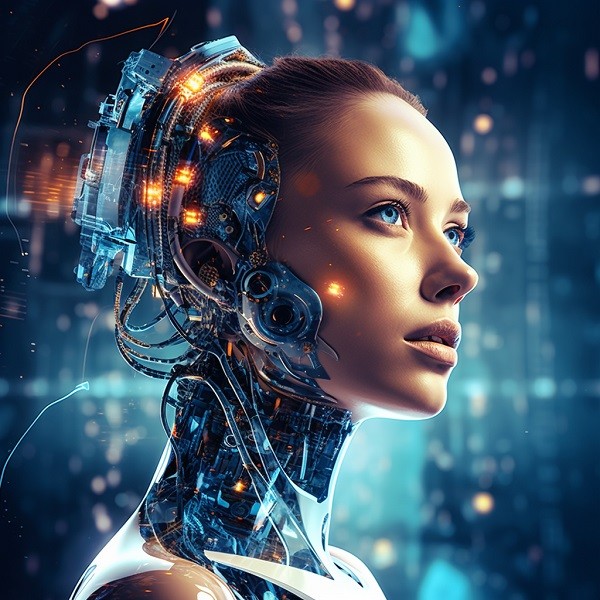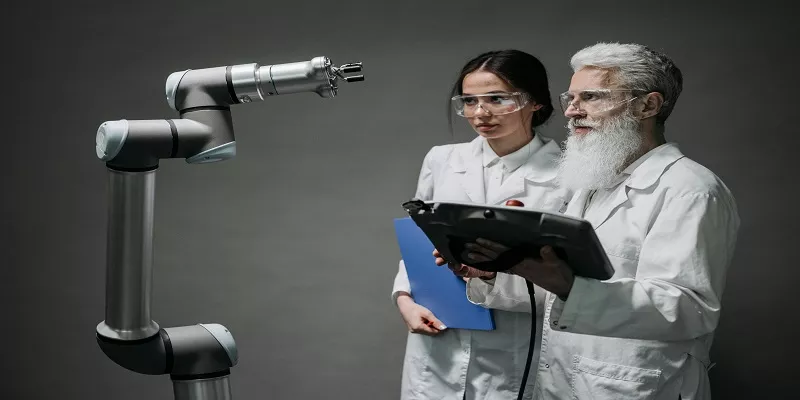Last Updated on May 9, 2025 by Jim C.
The convergence of AI and robotics is shaping the next generation of intelligent machines. With advanced technologies merging, we are witnessing a revolutionary era where artificial intelligence and robotics are coming together to create machines that can think, learn, and interact like humans.
This convergence has the potential to impact various industries and sectors, ranging from healthcare and manufacturing to transportation and customer service. As intelligent machines continue to evolve, they are expected to possess the ability to perform complex tasks efficiently, make autonomous decisions, and adapt to changing environments.
The integration of AI and robotics holds immense possibilities for transforming the way we live and work, promising advancements that were once confined to science fiction.

Impact Of AI And Robotics On Society
The evolution of AI and Robotics is reshaping society by advancing intelligent machines. This convergence paves the way for transformative technologies impacting various sectors and daily life. Embracing this new era of innovation can lead to improved efficiencies and expanded possibilities.
The convergence of AI and robotics is revolutionizing the way we live and work, with a profound impact on society. From enhancing efficiency in various industries to addressing ethical concerns and regulations, the combination of artificial intelligence and robotic technology is reshaping the future. Let’s explore the specific areas where this impact can be felt.
Enhancing Efficiency In Various Industries
The integration of AI and robotics is dramatically enhancing efficiency across multiple industries. Robotic automation is streamlining processes and reducing human error in manufacturing, leading to increased productivity. In healthcare, robots assisted by AI are enhancing precision in surgeries and providing personalized care to patients. Moreover, in agriculture, AI-powered robots are increasing crop yield by enabling more precise and efficient farming practices.
Addressing Ethical Concerns And Regulations
As AI and robotics become more prevalent in society, ethical concerns and regulations are becoming increasingly important. Ethical considerations arise as AI-controlled robots take on tasks previously performed by humans, raising questions about potential job displacement and the equitable distribution of resources. Additionally, ensuring the ethical use of AI in decision-making processes and programming robots to adhere to ethical standards is critical. Regulations and policies are required to govern the development and deployment of AI and robots, safeguarding against misuse and ensuring the ethical and responsible utilization of this technology.
The impact of AI and robotics on society is far-reaching, influencing the efficiency of various industries and prompting the need for ethical considerations and regulations to guide its application. As these technologies continue to advance, it becomes increasingly important to balance their potential benefits with the ethical and societal implications they carry.
Technological Advancements And Innovations
Technological advancements and innovations have paved the way for the convergence of AI and robotics, creating a new generation of intelligent machines. This remarkable combination is revolutionizing various industries, from healthcare to manufacturing, by enhancing automation and decision-making capabilities. In this blog post, we will explore the integration of machine learning and robotics, as well as the emerging trends in AI-driven robotics.
Integration Of Machine Learning And Robotics
The integration of machine learning and robotics has resulted in significant advancements in the capabilities of intelligent machines. Machine learning algorithms enable robots to learn from data, adapt to their environment, and improve their performance over time. By analyzing large amounts of data, robots can detect patterns, make predictions, and make informed decisions.
This integration allows robots to perform complex tasks with precision and efficiency, reducing the need for human intervention. For example, in the field of manufacturing, robots equipped with machine learning algorithms can optimize production processes, identify defects, and adjust parameters to improve quality control.
Emerging Trends In AI-driven Robotics
A myriad of emerging trends are shaping the landscape of AI-driven robotics. One such trend is the development of collaborative robots, also known as cobots. These robots are designed to work side by side with humans, assisting in tasks that require both physical strength and cognitive abilities. Cobots can enhance productivity, improve safety, and facilitate human-robot collaboration in various industries.
Another trend in AI-driven robotics is the integration of natural language processing (NLP) capabilities. Robots equipped with NLP technology can understand and respond to human commands, enabling more natural and intuitive human-robot interactions. This opens up opportunities for robots to assist in customer service, personal assistance, and healthcare, among other fields.
Furthermore, the development of autonomous robots is gaining momentum. These robots can operate independently, without continuous human input, and make decisions on their own. Autonomous robots have vast applications, from autonomous vehicles in transportation to autonomous drones in aerial surveillance and delivery services.
The integration of machine learning and robotics, along with the emerging trends in AI-driven robotics, are driving the development of the next generation of intelligent machines. These advancements are reshaping industries, enhancing automation, and improving efficiency. As technology continues to evolve, the potential for AI and robotics to revolutionize various sectors is immense.
Challenges And Limitations
Exploring the convergence of AI and robotics unveils challenges and limitations in advancing intelligent machines. Overcoming issues such as ethical dilemmas and technical constraints paves the way for the next generation of smarter robotics. Striking a balance between innovation and accountability is crucial in this evolving landscape.
We are living in an era where the convergence of artificial intelligence (AI) and robotics is revolutionizing the way machines function and interact with humans. While the potential for intelligent machines is immense, it is crucial to understand and address the challenges and limitations that come with this transformative technology. From technical constraints to safety and reliability concerns, several factors need to be considered and overcome in order to fully harness the power of AI and robotics.
Overcoming Technical Constraints
Creating intelligent machines that seamlessly integrate AI and robotics is not without its technical hurdles. One of the main challenges is processing power, as AI algorithms require significant computational resources to operate efficiently. To overcome this constraint, researchers are constantly pushing the boundaries of hardware capabilities, developing advanced processors and specialized chips designed specifically for AI tasks. Additionally, optimizing algorithms and utilizing cloud computing enables the distribution of computational load, lightening the burden on individual devices.
Another technical limitation is the interoperability of different AI systems and robotic platforms. AI algorithms and robotics software often operate on different frameworks, making it difficult for them to communicate and collaborate effectively. To tackle this issue, industry collaborations are necessary to develop open standards and protocols that facilitate seamless integration between AI and robotics technologies. Such partnerships can help create a common language for intelligent machines, enabling them to work together towards a unified goal.
Ensuring Safety And Reliability
As intelligent machines become more autonomous and capable of making decisions, ensuring their safety and reliability is of utmost importance. The unpredictable nature of AI algorithms introduces a degree of uncertainty, making it crucial to establish robust fail-safe mechanisms. This involves rigorous testing and validation processes to identify and mitigate potential risks and vulnerabilities. By employing techniques such as quality assurance, redundancy, and extensive simulation, developers can enhance the safety and reliability of AI-enabled robots.
Another critical aspect of safety is the ethical considerations surrounding AI and robotics. As machines become increasingly intelligent and autonomous, it is essential to define ethical frameworks and guidelines that govern their behavior. Ensuring that AI systems align with human values and principles is crucial to prevent unintended consequences or harmful outcomes. Collaborations between researchers, industry experts, and regulatory bodies can help establish these ethical standards, enabling the development of responsible and trustworthy intelligent machines.
While challenges and limitations exist, they should not overshadow the immense potential of the convergence of AI and robotics. By overcoming technical constraints and ensuring safety and reliability, we can pave the way for the next generation of intelligent machines that can transform industries, enhance productivity, and improve our daily lives. The key lies in embracing these challenges, finding innovative solutions, and unleashing the true power of this exciting technology.
Future Possibilities And Applications
The convergence of AI and robotics has opened up a realm of future possibilities and applications that are set to revolutionize numerous industries. Harnessing the power of intelligent machines holds the potential to enhance efficiency, accuracy, and automation across a broad spectrum of sectors, from healthcare to transportation and urban development.
Ai-robot Collaboration In Healthcare
The integration of AI and robotics in healthcare presents a groundbreaking prospect, paving the way for enhanced diagnosis, treatment, and patient care. Robotic surgical systems equipped with AI algorithms can facilitate precise, minimally invasive procedures, thus reducing recovery times and improving patient outcomes. Additionally, robotic caregivers incorporating AI capabilities can offer personalized assistance to elderly or disabled individuals, contributing to their overall well-being.
Autonomous Vehicles And Smart Cities
AI-powered robotics is poised to shape the future of transportation and urban infrastructure, particularly through the development of autonomous vehicles and the establishment of smart cities. The fusion of AI with robotics technologies enables the creation of self-driving cars, revolutionizing the way people commute while enhancing safety and sustainability. In smart cities, AI-driven robotic systems can optimize traffic flow, manage energy consumption, and enhance public safety, ultimately fostering a more efficient and sustainable urban environment.
Frequently Asked Questions
What Is The Role Of AI in Robotics?
AI enhances robots’ ability to learn, adapt, and make autonomous decisions.
How Is Ai Shaping The Future Of Robotics?
AI advancements drive innovation in robotics, creating intelligent and efficient machines.
Can Robotics With AI Revolutionize Industries?
Yes, the integration of AI in robotics leads to increased productivity and precision in various sectors.
What Are The Ethical Implications Of AI in Robotics?
Ethical concerns around AI in robotics include data privacy, job displacement, and safety regulations.
How Can Individuals Benefit From AI-Powered Robotics?
AI-driven robots offer assistance in healthcare, manufacturing, and automation, improving daily workflows and services.
Conclusion
In this ever-evolving landscape of AI and robotics, we have witnessed groundbreaking advancements that have revolutionized the way we perceive intelligent machines. The convergence of AI and robotics has unlocked endless possibilities, offering a glimpse into a future where these technologies seamlessly intertwine to bring forward a new era of innovation and human-machine collaboration.
As these two fields continue to merge and complement each other, it’s evident that the next generation of intelligent machines will be truly transformative, reshaping industries and reshaping our lives. Embracing this convergence will undoubtedly lead us toward a future of unprecedented potential and promise.

